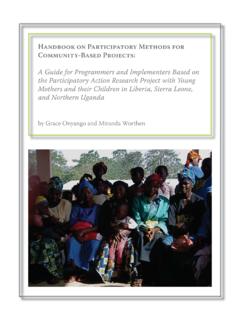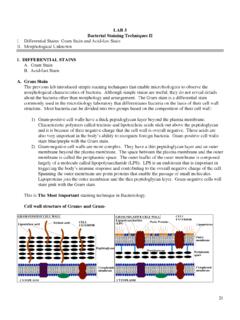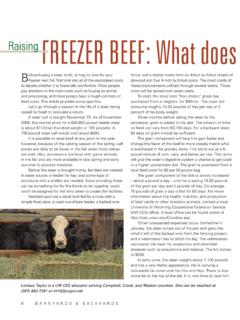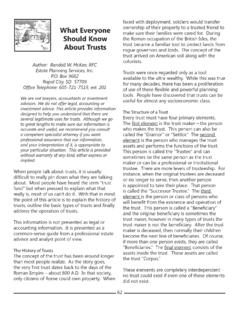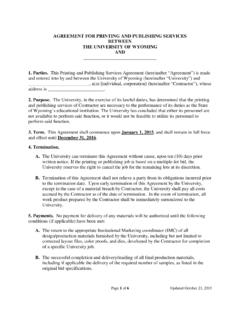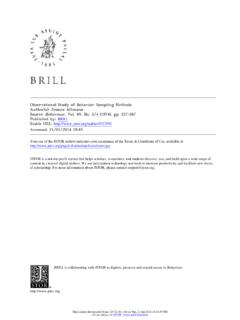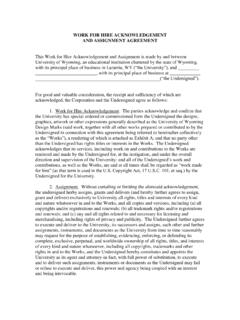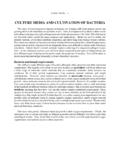Transcription of LAB 1 I. UBIQUITY OF MICROORGANISMS TERMS …
1 5 LAB 1 Introduction to Microscopy I. UBIQUITY of MICROORGANISMS II. Microscopy I. UBIQUITY OF MICROORGANISMS MICROORGANISMS are ubiquitous; that is, they are present nearly everywhere. In this lab you will try to isolate bacteria and other MICROORGANISMS from various sources using different types of media. TERMS AND DEFINITIONS Culture media (medium, singular): solution of nutrients required for the growth of bacteria. Agar: a carbohydrate derived from seaweed used to solidify a liquid medium. Tryptic Soy Agar (TSA): a rich solid medium containing a digest of casein (the principal milk protein) and soy products.
2 It is an all-purpose medium that supports the growth of many diverse organisms. Tryptic Soy Broth (TSB): a rich liquid medium containing a digest of casein and soy products. It is a general-purpose medium that supports the growth of organisms that are not exacting in their food requirements. Colony: a visible population of MICROORGANISMS originating from a single parent cell and growing on a solid medium. PROCEDURE: (EACH STUDENT) Collect 2 TSA plates and 1 TSB tube from the side bench. 1. Moisten a sterile swab with sterile water (see bottle on your bench). Using this swab, collect a sample from any surface or object ( doorknobs, shoes, drinking fountain, a strand of hair, various body parts, etc.)
3 Try whatever interests you and be creative. 2. After the sample has been collected, inoculate a Tryptic Soy Agar (TSA) plate by gently rolling the swab over the surface of the agar. Discard the used swab into a biohazard container. 3. Label the bottom of the plate with your name, lab section #, date, and the source of the sample. Write on the outer edge so that the markings won't interfere with observing the colonies growing on the plate. 4. Inoculate a second Tryptic Soy Agar plate by the following procedure. Open the lid of the plate, place it close to your mouth and cough hard 3 times onto the plate.
4 Place the lid back on. Correctly label your plate. 5. Inoculate a tube of Tryptic Soy Broth by removing the cap, putting your thumb over the top of the tube, and inverting the tube several times. Replace the cap. Label the tube with your name and lab section using a piece of tape. Do not write directly on the cap or tube. 6. Incubation: After inoculating culture media with MICROORGANISMS , it is usually incubated at a temperature that most closely mimics the organisms natural environments. *a. TSA swabbed plate - room temperature (RT) *b. TSA cough plate - body temperature--37 C incubator c. TSB tube - RT *Plates are always incubated in an inverted position (agar side up).
5 There are only a few exceptions to this rule that you will see later in the course. 6 II. MICROSCOPY In this exercise you will become familiar with a bright field microscope that you'll be using throughout the semester. TERMS AND DEFINITIONS Microscope: a device for magnifying objects that are too small to be seen with the naked eye. a. Simple microscope: single lens magnifier b. Compound microscope: employs two or more lenses Parfocal: the objective lenses are mounted on the microscope so that they can be interchanged without having to appreciably vary the focus. Resolving power or resolution: the ability to distinguish objects that are close together.
6 The better the resolving power of the microscope, the closer together two objects can be and still be seen as separate. Magnification: the process of enlarging the size of an object, as an optical image. Total magnification: In a compound microscope the total magnification is the product of the objective and ocular lenses (see figure below). The magnification of the ocular lenses on your scope is 10X. Objective lens Ocular lens = Total magnification For example: low power: (10X)(10X) = 100X high dry: (40X)(10X) = 400X oil immersion: (100X)(10X) = 1000X Immersion Oil: Clear, finely detailed images are achieved by contrasting the specimen with their medium.
7 Changing the refractive index of the specimens from their medium attains this contrast. The refractive index is a measure of the relative velocity at which light passes through a material. When light rays pass through the two materials (specimen and medium) that have different refractive indices, the rays change direction from a straight path by bending (refracting) at the boundary between the specimen and the medium. Thus, this increases the image s contrast between the specimen and the medium. One way to change the refractive index is by staining the specimen. Another is to use immersion oil. While we want light to refract differently between the specimen and the medium, we do not want to lose any light rays, as this would decrease the resolution of the image.
8 By placing immersion oil between the glass slide and the oil immersion lens (100X), the light rays at the highest magnification can be retained. Immersion oil has the same refractive index as glass so the oil becomes part of the optics of the microscope. Without the oil the light rays are refracted as they enter the air between the slide and the lens and the objective lens would have to be increased in diameter in order to capture them. Using oil has the same effect as increasing the objective diameter therefore improving the resolving power of the lens. 7 MICROSCOPE COMPONENTS MICROSCOPE CARE 1.
9 Never slide a microscope across a bench surface. Always carry a microscope with both hands. One hand should be placed on the arm and the other should support the base. 2. Microscopes should be cleaned both before and after use. Use ONLY lens paper and lens cleaner. Kleenex, paper towels and even Kimwipes can scratch the lenses. 3. ONLY use oil when using the100X oil immersion lens. DO NOT get oil on the other objective lenses. 4. Store microscopes with the 10X (low power) objective lens in position or such that the region lacking a lens is in position. Turn the light intensity all the way down. 5. DO NOT wrap the cord around the microscope.
10 Instead, fold the cord and place it between the arm and the stage or beneath the stage. 6. Use the course adjustment focusing knob to lower the stage towards the light source. DO NOT crank down on the knob! 7. Replace the dust cover before putting the microscope away. PROCEDURE: (EACH STUDENT) The primary objective of this exercise is to gain experience in using the bright field microscope. You will observe the microbial life present in pond water and hay infusions as you practice working with the microscope. 1. Place a slide on the lab bench frosted side up. The frosted section should feel rough. 8 2. Draw a line on the slide with a Sharpie marker.
